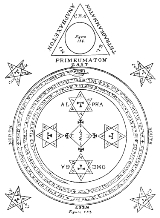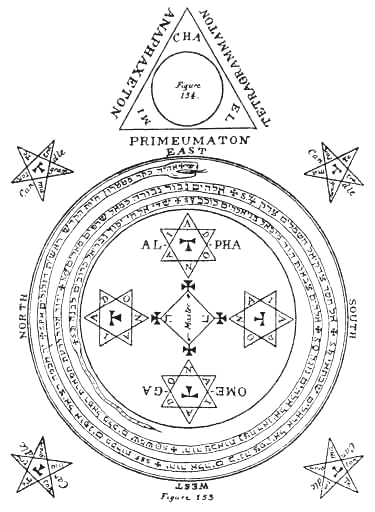
Magic circle
Encyclopedia

Magic (paranormal)
Magic is the claimed art of manipulating aspects of reality either by supernatural means or through knowledge of occult laws unknown to science. It is in contrast to science, in that science does not accept anything not subject to either direct or indirect observation, and subject to logical...
, which they generally believe will contain energy and form a sacred space, or will provide them a form of magical protection, or both. It may be marked physically, drawn in salt or chalk, for example, or merely visualised. Its spiritual significance is similar to that of mandala
Mandala
Maṇḍala is a Sanskrit word that means "circle". In the Buddhist and Hindu religious traditions their sacred art often takes a mandala form. The basic form of most Hindu and Buddhist mandalas is a square with four gates containing a circle with a center point...
and yantra
Yantra
Yantra is the Sanskrit word for "instrument" or "machine". Much like the word "instrument" itself, it can stand for symbols, processes, automata, machinery or anything that has structure and organization, depending on context....
in some Eastern religions.
Common terms and practices

Creating a magic circle is known as casting a circle, circle casting, and various other names.
There are many published techniques for casting a circle, and many groups and individuals have their own unique methods. The common feature of these practices is that a boundary is traced around the working area. Some witchcraft
Witchcraft
Witchcraft, in historical, anthropological, religious, and mythological contexts, is the alleged use of supernatural or magical powers. A witch is a practitioner of witchcraft...
traditions say that one must trace around the circle deosil three times. There is variation over which direction one should start in.
Circles may or may not be physically marked out on the ground, and a variety of elaborate patterns for circle markings can be found in grimoire
Grimoire
A grimoire is a textbook of magic. Such books typically include instructions on how to create magical objects like talismans and amulets, how to perform magical spells, charms and divination and also how to summon or invoke supernatural entities such as angels, spirits, and demons...
s and magical manuals, often involving angelic and divine names
Names of God
Names of God, or Holy Names, describe a form of addressing God present in liturgy or prayer of various world religions. Prayer involving the Holy Name or the Name of God has become established as common spiritual practice in both Western and Eastern spiritual practices...
. Such markings, or a simple unadorned circle, may be drawn in chalk or salt, or indicated by other means such as with a cord.
The four cardinal directions are often prominently marked, such as with four candles. In ceremonial magic
Ceremonial magic
Ceremonial magic, also referred to as high magic and as learned magic, is a broad term used in the context of Hermeticism or Western esotericism to encompass a wide variety of long, elaborate, and complex rituals of magic. It is named as such because the works included are characterized by...
traditions the four directions are commonly related to the four archangels Michael
Michael (archangel)
Michael , Micha'el or Mîkhā'ēl; , Mikhaḗl; or Míchaël; , Mīkhā'īl) is an archangel in Jewish, Christian, and Islamic teachings. Roman Catholics, Anglicans, and Lutherans refer to him as Saint Michael the Archangel and also simply as Saint Michael...
, Gabriel
Gabriel
In Abrahamic religions, Gabriel is an Archangel who typically serves as a messenger to humans from God.He first appears in the Book of Daniel, delivering explanations of Daniel's visions. In the Gospel of Luke Gabriel foretells the births of both John the Baptist and of Jesus...
, Raphael and Uriel
Uriel
Uriel is one of the archangels of post-Exilic Rabbinic tradition, and also of certain Christian traditions...
(or Auriel), or the four classical elements, and also have four associated names of God. Other ceremonial traditions have candles between the quarters, i.e. in the north-east, north-west and so on. Often, an incantation will be recited stating the purpose and nature of the circle, often repeating an assortment of divine and angelic names.
In Wicca
In WiccaWicca
Wicca , is a modern Pagan religious movement. Developing in England in the first half of the 20th century, Wicca was popularised in the 1950s and early 1960s by a Wiccan High Priest named Gerald Gardner, who at the time called it the "witch cult" and "witchcraft," and its adherents "the Wica."...
, a circle is typically nine feet in diameter, though the size can vary depending on the purpose of the circle, and the preference of the caster.
Some varieties of Wicca
Wicca
Wicca , is a modern Pagan religious movement. Developing in England in the first half of the 20th century, Wicca was popularised in the 1950s and early 1960s by a Wiccan High Priest named Gerald Gardner, who at the time called it the "witch cult" and "witchcraft," and its adherents "the Wica."...
use the common ceremonial colour attributions for their "quarter candles": yellow for Air
Air (classical element)
Air is often seen as a universal power or pure substance. Its supposed fundamental importance to life can be seen in words such as aspire, inspire, perspire and spirit, all derived from the Latin spirare.-Greek and Roman tradition:...
in the east, red for Fire
Fire (classical element)
Fire has been an important part of all cultures and religions from pre-history to modern day and was vital to the development of civilization. It has been regarded in many different contexts throughout history, but especially as a metaphysical constant of the world.-Greek and Roman tradition:Fire...
in the south, blue for Water
Water (classical element)
Water is one of the elements in ancient Greek philosophy, in the Asian Indian system Panchamahabhuta, and in the Chinese cosmological and physiological system Wu Xing...
in the west and green for Earth
Earth (classical element)
Earth, home and origin of humanity, has often been worshipped in its own right with its own unique spiritual tradition.-European tradition:Earth is one of the four classical elements in ancient Greek philosophy and science. It was commonly associated with qualities of heaviness, matter and the...
in the north (though these attributions differ according to geographical location and individual philosophy).
The common technique for raising energy within the circle is by means of a cone of power
Cone of power
The cone of power is a method of raising energy in ritual magic, especially Witchcraft. The term refers to the idea that the raised energy forms a cone with the circle forming its base. As a group the cone is formed by the coveners standing in a circle, holding hands, and focusing on a single point...
.
The barrier is believed to be fragile, so that leaving or passing through the circle would weaken or dispel it. This is referred to as "breaking the circle". It is generally advised that practitioners do not leave the circle unless absolutely necessary
In order to leave a circle and keep it intact, Wiccans believe a door must be cut in the energy of the circle, normally on the East side. Whatever was used to cast the circle is used to cut the doorway, such as a sword, staff or knife[athame], a doorway is "cut" in the circle, at which point anything may pass through without harming the circle. This opening must be closed afterwards by "reconnecting" the lines of the circle.
The circle is usually closed by the practitioner after they have finished by drawing in the energy with the athame or whatever was used to make the circle including their hand(usually in a widdershins
Widdershins
Widdershins means to take a course opposite the apparent motion of the sun, to go counterclockwise or lefthandwise, or to circle an object by always keeping it on the left...
, that is counter-clockwise, fashion). This is called closing the circle or releasing the circle. The term "opening" is often used, representing the idea the circle has been expanded and dissipated rather than closed in on itself.
Modern dreams and dream analysis
C. G. Jung comments on a significant dream of Wolfgang PauliWolfgang Pauli
Wolfgang Ernst Pauli was an Austrian theoretical physicist and one of the pioneers of quantum physics. In 1945, after being nominated by Albert Einstein, he received the Nobel Prize in Physics for his "decisive contribution through his discovery of a new law of Nature, the exclusion principle or...
where a snake describes a spellbinding magic circle about the dreamer, establishing a protected temenos
Temenos
Temenos is a piece of land cut off and assigned as an official domain, especially to kings and chiefs, or a piece of land marked off from common uses and dedicated to a god, a sanctuary, holy grove or holy precinct: The Pythian race-course is called a temenos, the sacred valley of the Nile is the ...
.

